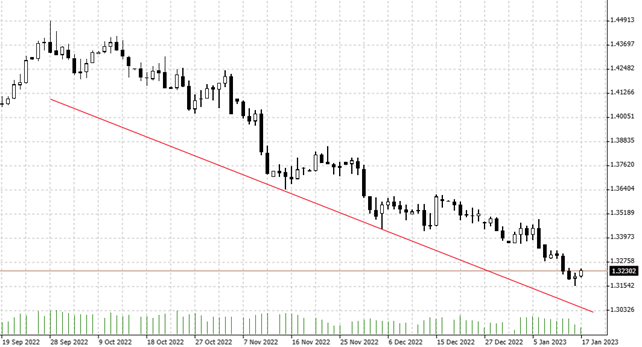

17.01.2023 – Beijing has just released economic figures – and the mainstream press is bent on missing the government’s targets. The data for the fourth quarter, on the other hand, speak a different language. They promise that the People’s Republic is giving the world’s stock markets a powerful bullish boost.
Before we get into the details, let’s take a look at USDSGD, a rather exotic currency pair that might be of interest to China fans – the Singapore dollar closely follows the yuan, according to experts at Focus Economics in Spain. And with the People’s Republic’s economy on the way up, as we’ll see in a moment, investors in the city-state have recently had to pay less and less for a greenback. Which is not surprising given the close ties with its big neighbor.

Source: Bernstein Bank GmbH
Let’s first look at what the quality and truth media have drawn from the numbers. For example, ARD reports from Shanghai that China’s economy “grew by 3 percent overall last year – far below the Chinese government’s official target. It is one of the weakest results in decades.” At least the broadcaster acknowledges that this is more than analysts expected – though without giving details. Finally, we learn that the Communist Party had issued a growth target of 5.5 percent in the spring. Growth was only slightly weaker in the first corona year of 2020. So far, so true – and so sketchy.
Challenges for Beijing
Indeed, big Red Dragon is having trouble restarting the economy after the Corona lockdowns; and the gigantic real estate bubble is also a threat. Furthermore, the shrinking population, reported for the first time since 1961, is worrisome. In this respect, some investors might assume that the seemingly catastrophic figures are now shaking the world’s stock markets. But the details are quite different.
Strong Q4
The financial blog “ZeroHedge”, for example, suspects that China has bounced back. Because the figures for the fourth quarter would have exceeded all expectations. Thus, economic growth in the last quarter was plus 2.9 percent – the forecasts of analysts were on average 1.6 percent. Industrial production in December rose by 1.3 percent year-on-year, while expectations were only 0.1 percent. The figures for the retail sector were particularly positive: the decline in sales in December was only minus 1.8 percent; experts had expected minus 9 percent. In addition, market expectations are solidifying that the state will support reeling project developers with loans equivalent to $24 billion.
On the way up
Ho Woei Chen, economist at United Overseas Bank in Singapore, commented that China’s recovery is likely to be stronger this first quarter as the country reopens borders and eases regulation in some sectors, such as real estate. Specifically, it said, “We are maintaining our forecast for 2023 at 5.2%. Economic recovery is likely to accelerate in 2Q as the population achieves herd immunity, which will pave the way for further normalization in activities and a v-shaped recovery in private consumption.”
Our conclusion: China once rocked world stock markets by exporting the Corona crisis. China made many products more expensive due to gaps in its supply chain. Now, however, the country appears to be on the mend. Which will boost demand for goods from the West – so we just got a bullish boost. We expect this to show up in analyst forecasts and prices sooner rather than later. Of course, that’s if no event like a new Corona wave or Taiwan invasion gets in the way. Bernstein Bank wishes successful trades and investments!
__________________________________________________________________________________________
The content of this publication is for general information purposes only. In this context, it is neither an individual investment recommendation or advice nor an offer to purchase or sell securities or other financial products. The content in question and all the information contained therein do not in any way replace individual investor- or investment-oriented advice. No reliable forecast or indication for the future is possible with respect to any presentation or information on the present or past performance of the relevant underlying assets. All information and data presented in this publication are based on reliable sources. However, Bernstein Bank does not guarantee that the information and data contained in this publication is up-to-date, correct and complete. Securities traded on the financial markets are subject to price fluctuations. A contract for difference (CFD) is also a financial instrument with leverage effect. Against this backdrop, CFD trading involves a high risk up to the point of total loss and may not be suitable for all investors. Therefore, make sure that you have fully understood all the correlating risks. If necessary, ask for independent advice. CFDs are complex instruments and are associated with the high risk of losing money quickly because of the leverage effect. 68% of retail investor accounts lose money trading CFD with this provider. You should consider whether you understand how CFD work and whether you can afford to take the high risk of losing your money.7
